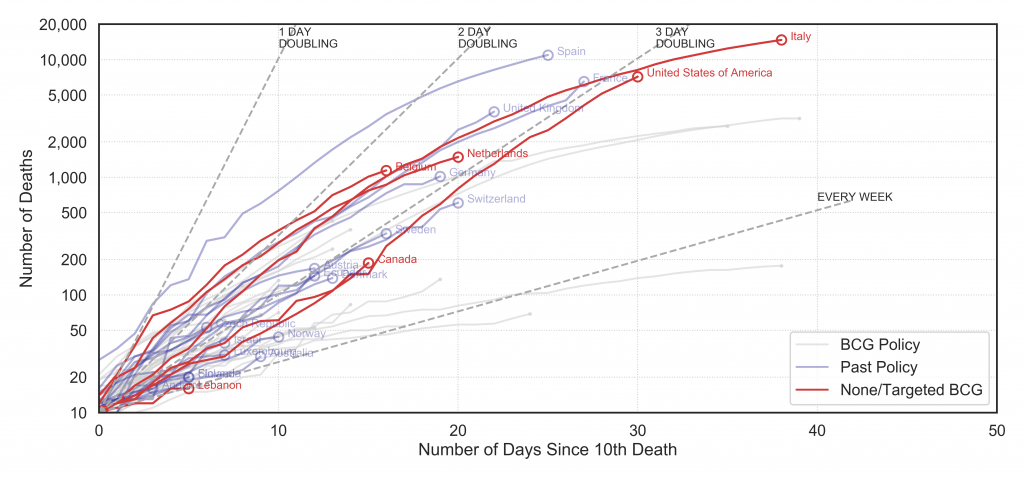
I spent a lot of the last couple of weeks in bed with an undiagnosed respiratory illness that may or may not have been COVID, so I was not up to doing much other than browsing twitter from time-to-time. I was curious about the research, highlighted by Luke O’Neill and others potentially linking susceptibility to COVID and national BCG vaccination policies.
My first thought, based on a colleagues tweet, was to be wary of thinking you can do epidemiology research.
Yes. Be careful of the “infectious disease epidemiology – how hard can it be” trap. https://t.co/XSp9oFoCqy
— Padraig Cunningham (@PadraigC) March 20, 2020
Ignoring the wise advice, and driven by curiosity, I decided to bootstrap some code from Barry Smyth and compare the European Centre for Disease Prevention and Control and the BCG world atlas to see if any trend could be visualised.
The results were interesting enough to me to write up and share, although, with the strong caveat that this was a rough exercise by a convalescent non-expert!
Background
The Covid-19 pandemic has resulted in over 1.3 million infections and 300,000 deaths 80,000 deaths between January and the 8th April 2020. Recently published papers suggest vaccination with Bacillus Calmette-Guérin (BCG) could have protective effects against viral infection. BCG has been in use since 1921 [1] and is a safe vaccine that has been shown in some trials to provide some level of protection for other a wide range of pathogens including viruses [2]. A number of randomised clinical trials have begun to investigate whether the BCG vaccine is playing a contributory role in suppressing the COVID-19 pandemic spread [3]. There has been speculation that a higher blanket immunity among the young could be providing a shield for the elderly in some countries, reducing the pandemic mortality rates~\cite{irishtimes2020}. In the interim, studies of the rates of mortality in the population could allow a better population based understanding of potential contributory factors. Zafirakis et al. [4] and [5] examined whether a relationship could be identified between national BCG vaccination programs and the mortality levels reported by countries.
Inspired by Shet et al. [6] who reported a COVID-19-attributable mortality among BCG-using countries as 5.8 times lower [95\% CI 1.8- 19.0] than in non BCG-using countries, this work sought to use existing data and visualisations with a simple linear regression model to illustrate this finding using only the raw daily cases and death statistics statistics and comparing for countries with different BCG vaccination policies.
Data Sources and Preparation
Daily cases and death statistics attributed to Covid-19 was sourced from the European Centre for Disease Prevention and Control. Per country BCG vaccination policy classifications was retrieved from the World Atlas of BCG [7]. The data was processed using scripts based on scripts from Barry Smyth developed to plot visualisations of daily cumulative cases and deaths inspired by the excellent daily update visualisations produced by John Burn-Murdoch of the Financial Times.
The BCG World Atlas categorised the database of policies and practices of the Bacillus Calmette-Guérin (BCG) vaccine from countries all over the world with details on the changes in policy over time. At a high level there are three main country policies: (a) Current national BCG vaccination policy for all; (b) Past national BCG vaccination policy for all; and (c) BCG recommendation only for specific groups or none at all.
More stratified categories from [7] based on the policy commencement year, subset of populations vaccinated, etc. are not considered here. Many other factors such as those considered in the modelling of [6] or other factors such as the levels of immigration, wealth, vaccination take-up and healthcare systems could also play a factor but are not considered.
Rate of increase in Cases and Deaths
The cumulative cases and deaths per country are plotted, colour-coded by BCG policy class in Fig. 1 and Fig. 2. Both graphs plot the cumulative number of cases per day with a log scaled y-axis. The grey dashed lines show what a trend following an exponential doubling of cases per day, two days etc. would follow. They are plotted from day zero when 100 cases identified in Fig. 1 and 10 deaths occurs in Fig. 2. It should be noted that the reporting on cases varies by country and even within countries as the testing criteria, protocol and capacity change. Hence the daily cases should be treated as unreliable.
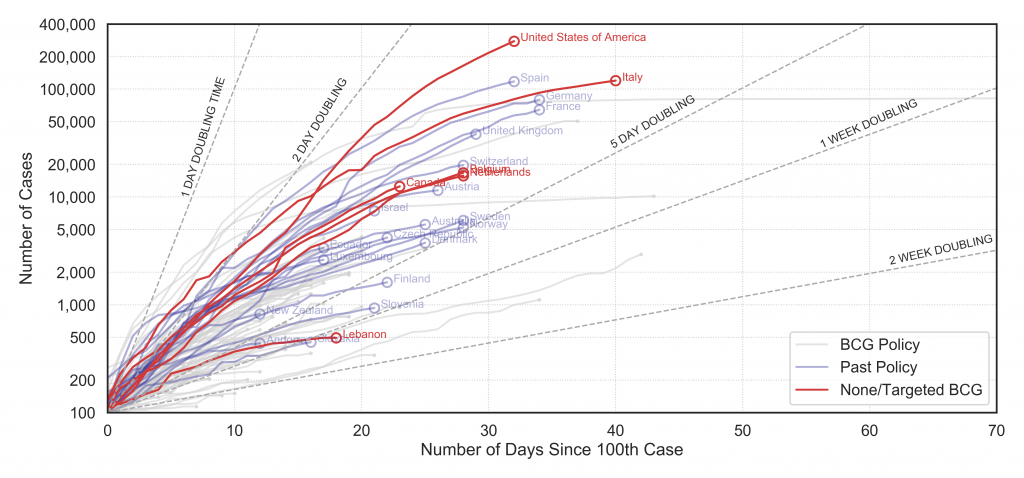

In Fig. 2, the cumulative deaths reported are plotted. This data has some of the same quality issues, e.g. deaths outside hospitals are delayed in reporting, are mis-classified or are reported in bulk on a lagging timescale. However, it can be considered better than the cases data in terms of quality.
Looking at both graphs there is a sense that there is a trend that the red and blue lines (i.e. classes with less or no vaccination) are following steeper trends than the grey lines but it is difficult interpret.
Rate of increase in Cases and Deaths
In order to compare across countries in a consistent manner, the maximum slope of the cumulative cases and deaths per country are computed as a linear regression fit over 5 day windows. This gives an indication of the peak rise in cases and deaths. These are plotted in Fig. 3. For both a trend emerges in the red and blue lines (None/Targeted BCG and Past Policy) having steeper trajectories. The outliers are countries like Lebanon and Andorra with relatively low numbers of cases and deaths reported to date.
This data is also visualised in Fig. 4 where the full distribution of slopes are plotted in a 12 bin histogram and dashed lines indicate the slopes of the countries outside of full population vaccination class (a). Again, the cases are noisy but do illustrate the skew. The deaths highlight that all the dashed red lines except one outlier (Lebanon) lie in the top third of the peak slope distributions.
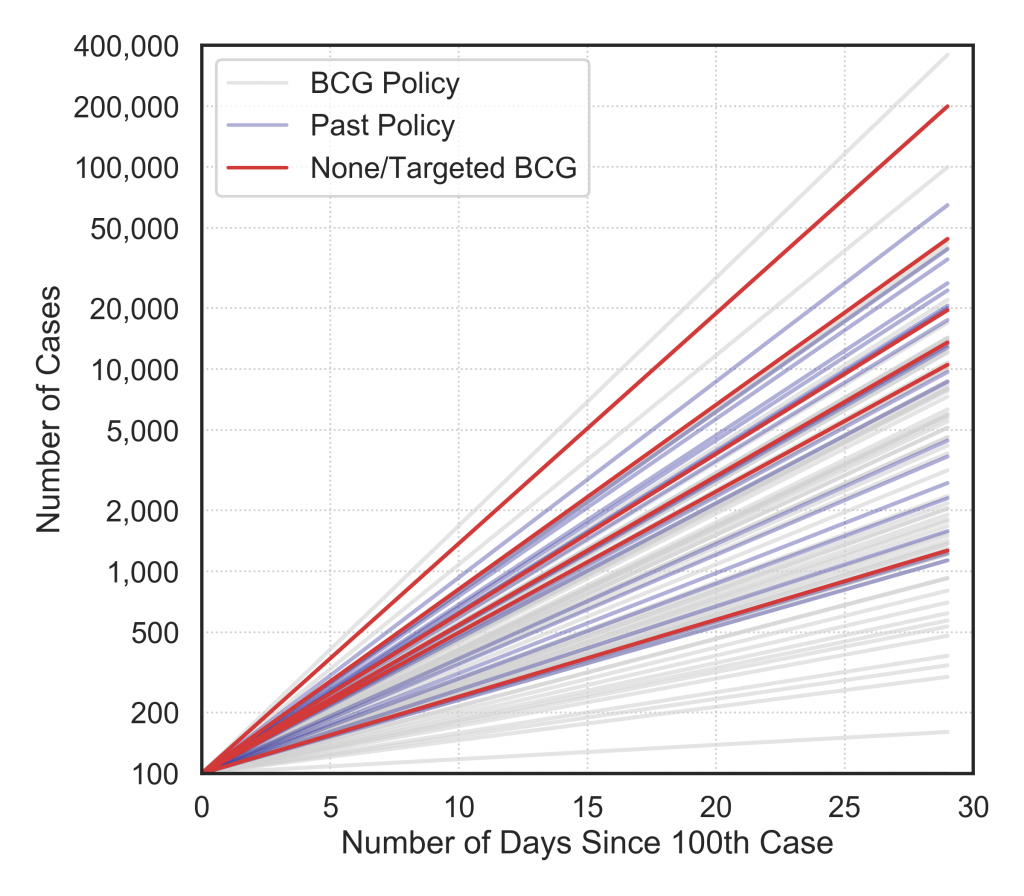
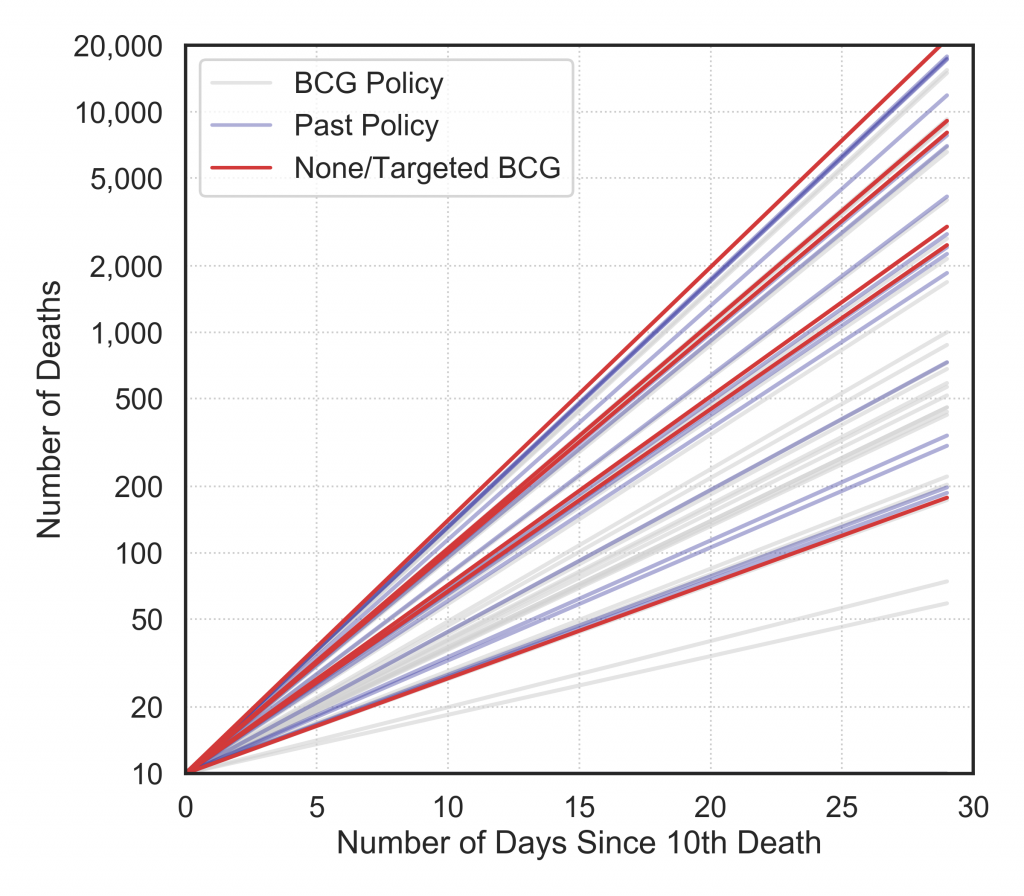
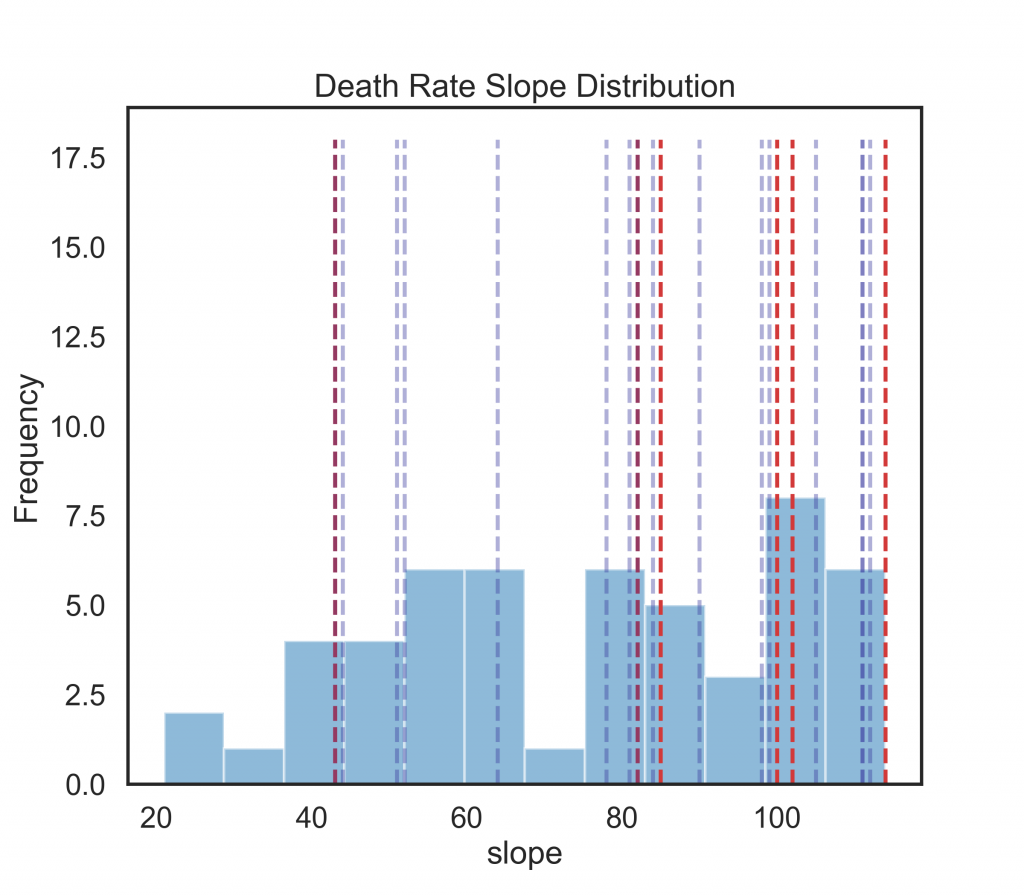
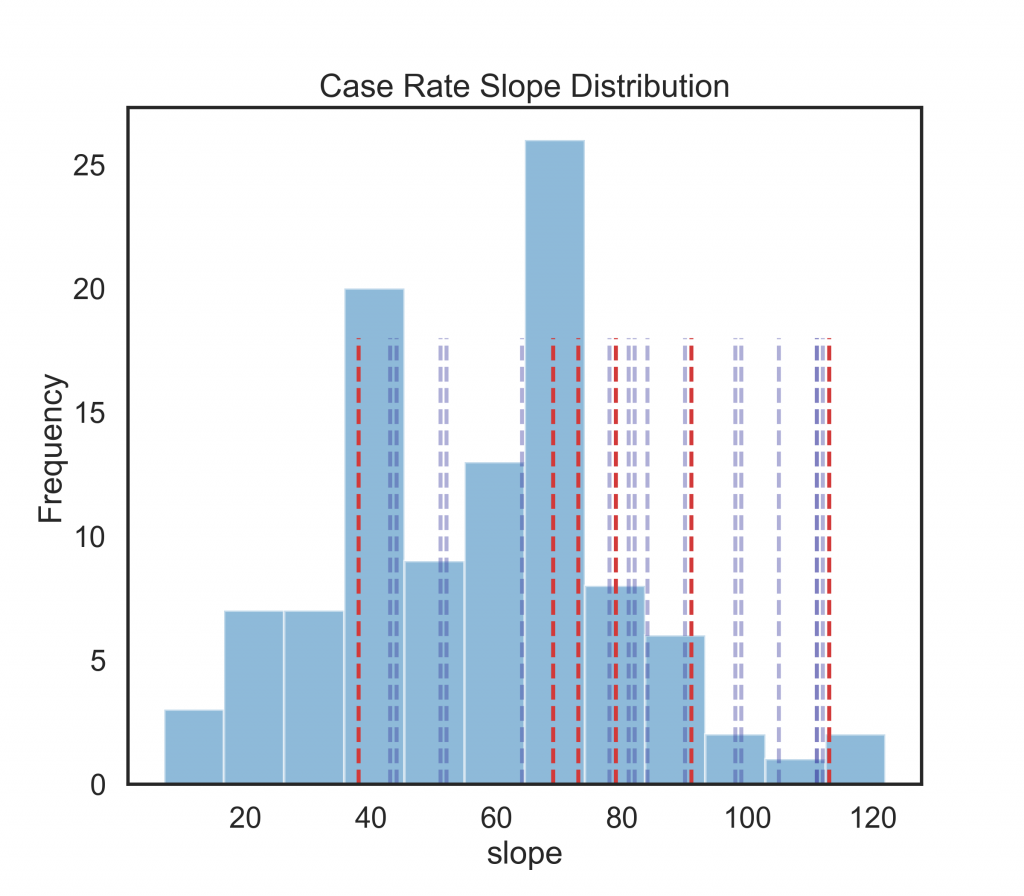
Conclusions
It may be simplistic to draw too much from a simple linear regression maximum slope over 5 days analysis. However, the daily COVID-19 case and death statistics reported show a correlation trend with national BCG vaccination policies that is similar to the findings reported in [6]. Followup analysis when the countries that are still in the earlier stages of the pandemic report further cases and mortality may clarify whether the outliers are due to noisy data or significant factors.
References
- World Health Organization. BCG vaccine: WHO position paper, February 2018 – recommendations. Vaccine, 36(24):3408–3410, Jun 2018.
- Jop Vrieze. Can a century-old TB vaccine steel the immune system against the new coronavirus? Science, Mar 2020.
- David Alnwick. Letter to the editor: Struggling to combat Covid-19. The Irish Times, 7 Apr 2020.
- Helen Zafirakis Andrew DiNardo Paul K. Hegarty, Ashish Kamat. Bcg vaccination may be protective against covid-19. ResearchGate Preprint, 2020.
- Elisabeth Mahase. Covid-19: what treatments are being investigated? BMJ, page m1252, Mar 2020.
- Anita Shet, Debashree Ray, Neelika Malavige, Mathuram Santosham, and Naor Bar-Zeev. Differential covid-19- attributable mortality and bcg vaccine use in countries. medRxiv, 2020.
- Alice Zwerling, Marcel A Behr, Aman Verma, Timothy F Brewer, Dick Menzies, and Madhukar Pai. The BCG world atlas: a database of global BCG vaccination policies and practices. PLoS medicine, 8(3), 2011.
